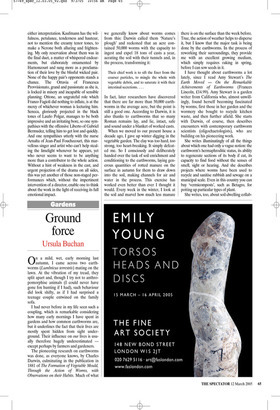Ground force
Ursula Buchan
On a mild, wet, early morning last autumn, I came across two earthworms (Lumbricus terrestris) mating on the lawn. At the vibration of my tread, they split apart and, though I try not to anthropomorphise animals (I could never have gone fox hunting if I had), such behaviour did look shifty, as if I had surprised a teenage couple entwined on the family sofa.
I had never before in my life seen such a coupling, which is remarkable considering how many early mornings I have spent in gardens and how common earthworms are, but it underlines the fact that their lives are mostly spent hidden from sight underground. Their influence on our lives is usually therefore hugely underestimated except perhaps by farmers and gardeners.
The pioneering research on earthworms was done, as everyone knows, by Charles Darwin, culminating in the publication in 1881 of The Formation of Vegetable Mould, Through the Action of Worms, with Observations on their Habits. Much of what we generally know about worms comes from this: Darwin called them ‘Nature’s plough’ and reckoned that an acre contained 50,000 worms with the capacity to ingest and expel 18 tons of casts a year, aerating the soil with their tunnels and, in the process, transforming it:
Their chief work is to sift the finer from the coarser particles, to mingle the whole with vegetable debris, and to saturate it with their intestinal secretions....
In fact, later researchers have discovered that there are far more than 50,000 earthworms in the average acre, but the point is still a good one. According to Darwin, it is also thanks to earthworms that so many Roman remains lay, and lie, intact, safe and sound under a blanket of worked casts.
When we moved to our present house a decade ago, I gave up winter digging in the vegetable garden. The clay was too hard, too strong, too heart-breaking. It simply defeated me. So I consciously and deliberately handed over the task of soil enrichment and conditioning to the earthworms, laying generous quantities of rotted manure on the surface in autumn for them to draw down into the soil, making channels for air and water in the process. This exercise has worked even better than ever I thought it would. Every week in the winter, I look at the soil and marvel how much less manure there is on the surface than the week before. True, the action of weather helps to disperse it, but I know that the major task is being done by the earthworms. In the process of reworking their surroundings, they provide me with an excellent growing medium, which simply requires raking in spring, before I can sow seeds in it.
I have thought about earthworms a lot lately, since I read Amy Stewart’s The Earth Moved — On the Remarkable Achievements of Earthworms (Frances Lincoln, £14.99). Amy Stewart is a garden writer from California who, almost unwillingly, found herself becoming fascinated by worms, first those in her garden and the wormery she bought to recycle kitchen waste, and then further afield. She starts with Darwin, of course, then describes encounters with contemporary earthworm scientists (oligochaetologists), who are building on his pioneering work.
She writes illuminatingly of all the things about which one had only a vague notion: the earthworm’s hermaphroditic status, its ability to regenerate sections of its body if cut, its capacity to find food without the senses of smell, sight or hearing. And she describes projects where worms have been used to recycle and sanitise rubbish and sewage on a municipal scale. Even in this country you can buy ‘vermicomposts’, such as Betagro, for potting up particular types of plant.
She writes, too, about soil-dwelling collab orators: the nematodes, bacteria, fungi, protozoa and arthropods, all connected to the mighty earthworm in a web of interdependence. The ground beneath our feet is a riveting place, if we only care to look down as full of interest as the sky above our heads.
Amy Stewart is an elegant and thoughtful writer, who has made the most of a subject which inspires awe, at least in me. After all, as she says, ‘fertile soil is a powerful engine for change’. But there is also cold dread. For, if something catastrophic happened to Lumbricus terrestris — for example, if a rise in soil temperature chased them deep, deep underground or their alien predator, the New Zealand flatworm, really took a hold in this country where would we all be?
Right now, however, we can only be grateful that they do exist. There is something so grand about their achievements that even the most arrogant among us must pause for uncomfortable reflection. Read this book and you may find that your worldview alters; that you begin to feel like the humble one, creeping about on the surface of the earth, while the subterraneandwelling, blind and deaf earthworm is king.

































































 Previous page
Previous page